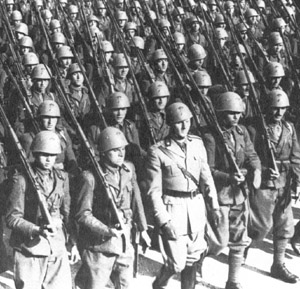Version: For The Motherland [FTM 3.05]
Country: Italy
Difficulty: Hard
__________________________________________________________________________________________________________________________________
The state of the empire is not so well. Mussolini will have to address the people in a few days on January the 14th of 1936, and he has not one shred of good news to tell the public.
"Should I remind them that the trains run on time?" He asked.
"No." I rejected blatantly.
"Then what?! Eight million bayonets?"
"No. Too soon."
Mussolini, or boss as he likes to be called, has no idea how to run a country. I do all the background work and I keep everything running. I'm his aide, he calls me "Il Baron" to indicate my importance to his clique. I kid you not, I do everything around here.
"Promise them victory in Ethiopia" I said.
"That's genius!" He replied fanatically.
Mussolini then rushed out to his balcony 20 minutes early declaring "We Will Win!" and people began to chat along.
1936:
1- War with Ethiopia - The Battle Plan
2- Armed Forces Evaluation - 1936
3- Industry, Research, & Production Strategies
4- Theories & Strategies
5- A Year in Review
1937:
1- Political Atmosphere - 1937
2- Armed Forces Evaluation - 1937
3- The End of Ethiopia
4- The Zadar-Split Incident: War with Yugoslavia
5- Diplomatic Relations, The Fall of Yugoslavia, & War with Bulgaria
Country: Italy
Difficulty: Hard
__________________________________________________________________________________________________________________________________
The state of the empire is not so well. Mussolini will have to address the people in a few days on January the 14th of 1936, and he has not one shred of good news to tell the public.
"Should I remind them that the trains run on time?" He asked.
"No." I rejected blatantly.
"Then what?! Eight million bayonets?"
"No. Too soon."
Mussolini, or boss as he likes to be called, has no idea how to run a country. I do all the background work and I keep everything running. I'm his aide, he calls me "Il Baron" to indicate my importance to his clique. I kid you not, I do everything around here.
"Promise them victory in Ethiopia" I said.
"That's genius!" He replied fanatically.
Mussolini then rushed out to his balcony 20 minutes early declaring "We Will Win!" and people began to chat along.
Table of Contents
1936:
1- War with Ethiopia - The Battle Plan
2- Armed Forces Evaluation - 1936
3- Industry, Research, & Production Strategies
4- Theories & Strategies
5- A Year in Review
1937:
1- Political Atmosphere - 1937
2- Armed Forces Evaluation - 1937
3- The End of Ethiopia
4- The Zadar-Split Incident: War with Yugoslavia
5- Diplomatic Relations, The Fall of Yugoslavia, & War with Bulgaria
Last edited:














